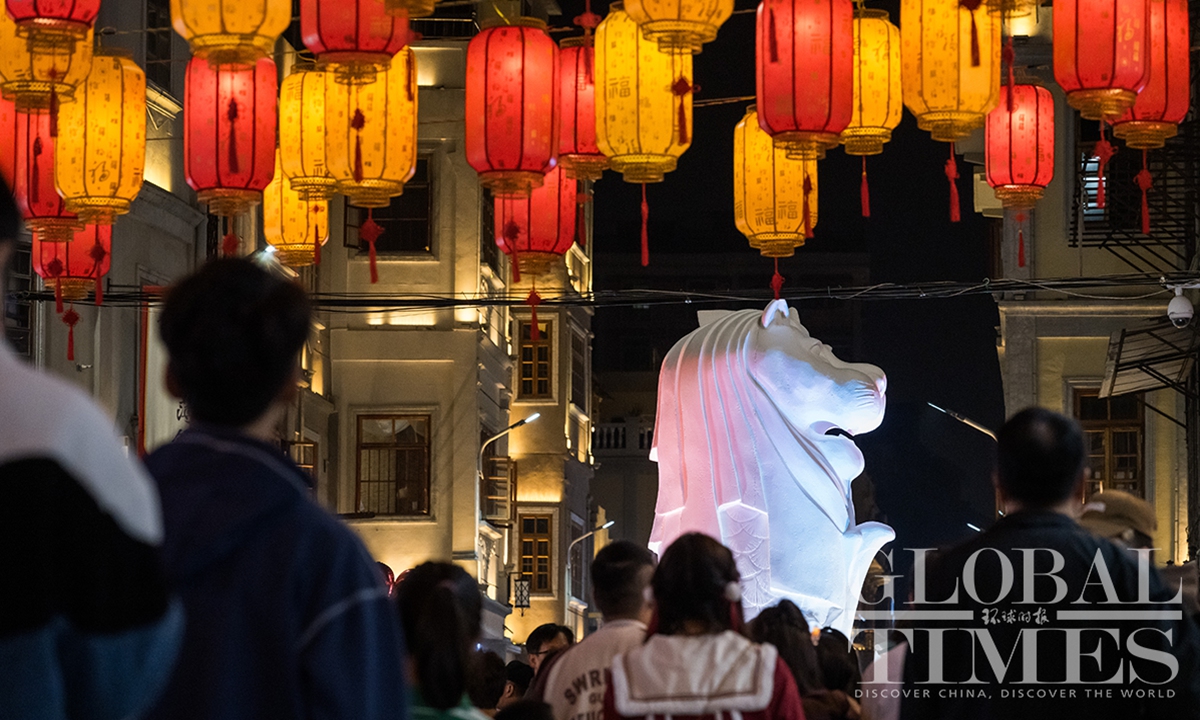
Photo: Chen Tao/GT
Spectacular lantern displays and a series of carnivals involving lighting lanterns, folk dances and lantern riddles were organized across China on the Lantern Festival, the 15th day of the first lunar month, which fell on Saturday in 2024.
Aiming to create a festive atmosphere, the 2024 Shantou International Lantern Show kick-started in Shantou, a city in South China's Guangdong Province that boasts a large population of returned overseas Chinese from countries such as Thailand and Singapore. It will last until March 15.
The event was held at Shantou Small Park, a historical place and scenic spot. It was highlighted by performances by several of the city's famous Yingge dance teams.
The Yingge dance, a kind of folk dance, is no doubt a Shantou's special art. Zhang, a 26-year-old dancer, told the Global Times that his team had rehearsed "more than three times" for the event before presenting the Chaoyang Yingge dance.
As its name suggests, the traditional Chinese Lantern Festival would not be complete without lantern displays.
Yet unlike many lantern shows in other parts of the country that feature unique local aesthetics, the Shantou lantern display appears to be much more "international" due to the city's history of being a centuries-old international port.
Iconic landmarks such as the Merlion statue in Singapore have been turned into creative lanterns displayed at Shantou Small Park.
These artworks demonstrate how local folk culture has complemented the city's unique character of being a "hometown of Chinese people returning from overseas."
Zheng Qiuxing, a local resident who chose to return from Malaysia, told the Global Times that the Chaoshan's tradition has always been a light in his heart guiding his "way back home."
Zheng also said that the traditional festival was a "great opportunity" to teach his children about his family's cultural roots.
Other than dazzling lanterns, the festival was also enriched by other folk activities like guessing lantern riddles and performing Chaoshan Opera.
Wu Jialing, an opera performer who debuted with her partner at the 2024 CCTV Spring Festival Gala, told the Global Times that this traditional art form can "now engage more young audiences all around the world" thanks to the increasing reputation of the local culture.
The public event saw the participation of locals and tourists, especially young ones.
Dressed in her favorite Hanfu dress (the traditional Chinese garment of the Han ethnic group), Liang, a young girl at the event, told the Global Times that she "would not let go of an opportunity to showcase her pride of being a Shantou local."
Similar cultural events could also be seen in many other cities in China on the Lantern Festival.
For example, the Cross-Straits Folk Culture Festival 2024 was held in Fuzhou, East China's Fujian Province. Six special exhibition areas fully displayed the cultural style of Fujian Province and the island of Taiwan.
The busy folk culture exhibition and intangible cultural heritage market was full of compatriots on both sides of the Straits celebrating the traditional festival together.
The lantern fair in Shanghai's Yuyuan Garden, one of China's national intangible cultural heritages, also made its way to Paris, marking the 60th anniversary of the establishment of diplomatic relations between China and France. It showcased both the beauty of China's lanterns and the charm of China's ancient literary work
Shan Hai Jing, also known as the Classic of Mountains and Seas.
Yu Jinlong, a cultural critic based in Beijing, told the Global Times that the Lantern Festival is regarded as the last climax of the Spring Festival because after this day, people will officially return to work in the new year.
It represents good wishes, including "reunion, harmony and the pursuit of happiness," which can be seen from the celebratory snacks eaten during the festival, the glutinous rice balls called yuanxiao or tangyuan, representing Chinese people's yearning for a better life.




